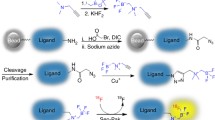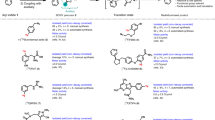Abstract
The biomarker 2-(1-{6-[(2-[18F]fluoroethyl)(methyl)amino]-2-naphthyl}ethylidene)malononitrile ([18F]FDDNP) is used as a positron emission tomography (PET) imaging probe for Alzheimer’s disease and other neurodegenerative diseases. A high-yield and fully automated synthesis of [18F]FDDNP—along with the synthesis and characterization of non-radioactive FDDNP, a fluorescent probe derived from 2-(1,1-dicyanopropenyl-2)-6-dimethylaminonaphthalene (DDNP)—are reported. Radiofluorination of the tosyloxy precursor 2-{[6-(2,2-dicyano-1-methylvinyl)-2-naphthyl](methyl)amino}ethyl-4-methylbenzenesulfonate (DDNPTs) with K18F/Kryptofix 2.2.2. yielded chemically (>99%) and radiochemically (>99%) pure [18F]FDDNP in high radiochemical yields (40–60%; n> 120), with specific activities ranging from 4 to 8 Ci/μmol at the end of synthesis (90 minutes). Both remote, semiautomated and automated synthesis procedures are described. Either approach provides a reliable method for production of large quantities (110–170 mCi from 500 mCi of [18F]fluoride) of [18F]FDDNP allowing for multiple PET experiments in the same day or for distribution of the tracer from a single cyclotron facility to PET imaging centers at various geographical distances.







Similar content being viewed by others
References
Evans DA (1990) Estimated prevalence of Alzheimer’s disease in the United States. Milbank Q 68:267–289
Salmon DP, Lange KL (2001) Cognitive screening and neuropsychological assessment in early Alzheimer’s disease. Clin Geriatr Med 17:229–254
Vickers JC, Dickson TC, Adlard PA, et al. (2000) The cause of neuronal degeneration in Alzheimer’s disease. Prog Neurobiol 60:139–165
Braak H, Braak E (1991) Neuropathological staging of Alzheimer-related changes. Acta Neuropathol 82:239–259
Hof PR (1997) Morphology and neurochemical characteristics of the vulnerable neurons in brain aging and Alzheimer’s disease. Eur Neurol 37:71–81
Glenner GG, Eanes ED, Page, DL (1972) The relation of the properties of Congo red-stained amyloid fibrils to the β-conformation. J Histochem Cytochem 20:821–826
Jacobson A, Petrič A, Hogenkamp D, et al. (1996) 1,1-Dicyano-2-(6-dimethylaminonaphthalen-2-yl)propene (DDNP): a solvent polarity and viscosity sensitive fluorophore for fluorescence microscopy. J Am Chem Soc 118:5572–5579
Agdeppa ED, Kepe V, Liu J, et al. (2001) Binding characteristics of radiofluorinated 6-dialkylamino-2-naphthylethylidene derivatives as positron emission tomography imaging probes for β-amyloid plaques in Alzheimer’s disease. J Neurosci 21:RC189 (1–5)
Barrio JR, Huang S-C, Cole G, et al. (1999) PET imaging of tangles and plaques in Alzheimer disease with a highly hydrophobic probe. J Labelled Compd Radiopharm 42 (Suppl1):S194–S195
Agdeppa ED, Kepe V, Liu J, et al. (2003) 2-Dialkylamino-6-acylmalononitrile substituted naphthalenes (DDNP analogs): novel diagnostic and therapeutic tools in Alzheimer’s disease. Mol Imaging Biol 5:404–417
Agdeppa ED, Kepe V, Petriè A, et al. (2003) In vitro detection of (S)-naproxen and ibuprofen binding to plaques in the Alzheimer’s brain using the positron emission tomography molecular imaging probe 2-(1-{6-[(2[F-18]fluoroethyl)(methyl)amino]-2-naphthyl}ethylidene)malononitrile. Neuroscience 117:723–730
Shoghi-Jadid K, Small GW, Agdeppa ED, et al. (2002) Localization of neurofibrillary tangles and beta-amyloid plaques in the brains of living patients with Alzheimer disease. Am J Geriatr Psychiatry 10:24–35
Kepe V, Barrio JR, Huang S-C, et al. (2006) Serotonin 1A receptors in the living brain of Alzheimer’s disease patients. Proc Natl Acad Sci USA 103:702–707
Kepe V, Cole GM, Liu J, et al. (2005) [18F]FDDNP microPET imaging of β-amyloid deposits in the living brain of triple transgenic rat model of β-amyloid deposition. Mol Imaging Biol 7:105
Bresjanac M, Smid LM, Vovko TD, et al. (2003) Molecular-imaging probe 2-(1-{6-[(2-fluoroethyl)(methyl)amino]-2-naphthyl}ethylidene) malononitrile labels prion plaques in vitro. J Neurosci 23:8029–8033
Kurihara A, Pardridge WM (2000) Aβ1–40 peptide radiopharmaceuticals for brain amyloid imaging: 111In chelation, conjugation to poly(ethylene glycol)-biotin linkers, and autoradiography with Alzheimer’s disease brain sections. Bioconjug Chem 11:380–386
Harpstrite SE, Prior J, Piwnica-Worms D, et al. (2005) Peptide conjugates for imaging β-amyloid in the brain. J Labelled Compd Radiopharm 48:S228
Kung HF, Kung M-P, Zhuang ZP, et al. (2003) Iodinated tracers for imaging amyloid plaques in the brain. Mol Imaging Biol 5:418–426
Cai L, Chin FT, Pike VW, et al. (2004) Synthesis and evaluation of two 18F-labeled 6-iodo-2-(4′-N,N-dimethylamino)phenylimidazo[1,2-a]pyridine derivatives as prospective radioligands for β-amyloid in Alzheimer’s disease. J Med Chem 47:2208–2218
Suemoto T, N. Okamura N, Shiomitsu T, et al. (2004) In vivo labeling of amyloid with BF-108. Neurosci Res 48:65–74
Okamura N, Suemoto T, Shimadzu H, et al. (2004) Styrylbenzoxazole derivatives for in vivo imaging of amyloid plaques in the brain. J Neurosci 24:2535–2541
Kumar P, Zheng W, McQuarrie SA, et al. (2005) 18F-FESB: synthesis and automated radiofluorination of a novel 18F-labeled PET tracer for β-amyloid plaques. J Labelled Compd Radiopharm 48:983–996
Ono M, Yoshida N, Ishibashi K, et al. (2005) Radioiodinated flavones for in vivo imaging of β-amyloid plaques in the brain. J Med Chem 48:7253–7260
Klunk WE, Engler H, Nordberg A, et al. (2004) Imaging brain amyloid in Alzheimer’s disease with Pittsburgh Compound-B. Ann Neurol 55:306–319
Verhoeff NP, Wilson AA, Takeshita S, et al. (2004) In-vivo imaging of Alzheimer disease beta-amyloid with [11C]SB-13 PET. Am J Geriatr Psychiatry 12:584–595
Petrič A, Špes T, Barrio JR (1998) Novel fluorescent reactive dyes as intermediates for the preparation of UV and Vis wavelength fluorescent probes. Monatsh Chem 129:777–786
Nebeling B, Padgett HC (2006) explora RN: a general purpose and fully automated nucleophilic [18F]fluorination system. Mol Imaging Biol 8:96
Satyamurthy N, Amarasekera B, Alvord CW, Barrio JR, Phelps ME (2002) Tantalum [18O]water target for the production of [18F]fluoride with high reactivity for the preparation of 2-deoxy-2-[18F]fluoro-d-glucose. Mol Imaging Biol 4:65–70
Golubev AS, Schedel H, Radics G, et al. (2004) Hexafluoroacetone as a protecting and activating reagent: 5,5-difluoro- and trans-5-fluoropipecolic acids from glutamic acid. Tetrahedron Lett 45:1445–1447
Patai S, Rappoport Z (1962) Nucleophilic attack on carbon–carbon double bonds. II. Cleavage of arylmethylenemalononitriles by water in 95% ethanol. J Chem Soc 383–391
Bernasconi CF, Howard KA, Kanavarioti A (1984) Nucleophilic addition to olefins. 11. Kinetics of the reversible hydrolysis of benzylidenemalononitrile in water. J Am Chem Soc 106:6827–6835
Žabjek A, Petrič A (1999) A general method for the alkaline cleavage of enolisable ketones. Tetrahedron Lett 40:6077–6078
Wellenfels K, Friedrich K, Rieser J, et al. (1976) The analogy between O and C(CN)2. Angew Chem Int Ed Engl 15:261–270
Karlsen H, Songe PH, Sunsby LK, et al. (2001) Regiochemistry in alkylation, acylation and methoxycarbonylation of alkali salts from 2-substituted alkenylpropanedinitriles. J Chem Soc, Perkin Trans 1:497–507
Acknowledgments
The authors would like to thank the staff at the UCLA Biomedical Cyclotron for the help provided during the optimization of the [18F]FDDNP radiosynthesis. This work was supported by Department of Energy grant DE-FC03-02ER-ER63420.
Author information
Authors and Affiliations
Corresponding author
Rights and permissions
About this article
Cite this article
Liu, J., Kepe, V., Žabjek, A. et al. High-Yield, Automated Radiosynthesis of 2-(1-{6-[(2-[18F]Fluoroethyl)(methyl)amino]-2-naphthyl}ethylidene)malononitrile ([18F]FDDNP) Ready for Animal or Human Administration. Mol Imaging Biol 9, 6–16 (2007). https://doi.org/10.1007/s11307-006-0061-4
Published:
Issue Date:
DOI: https://doi.org/10.1007/s11307-006-0061-4




